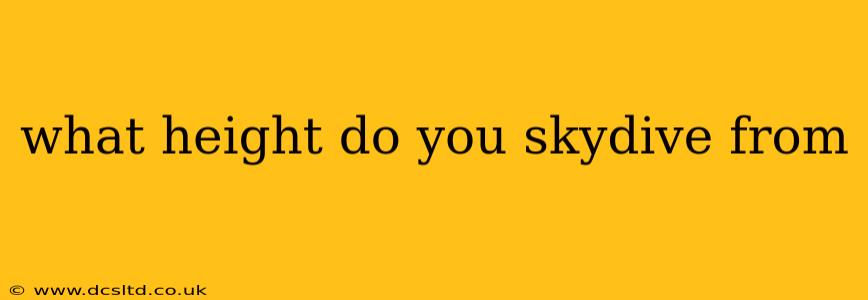The height from which you skydive isn't a single, universal number. It varies depending on several factors, including the type of jump, the experience level of the skydiver, and the specific dropzone regulations. Let's explore the common jump altitudes and why they differ.
What are the typical skydiving altitudes?
Most recreational skydives take place from altitudes between 10,000 and 14,000 feet (3,000 and 4,200 meters) above ground level (AGL). This provides ample freefall time, usually around 60 seconds, before deploying the parachute. Higher altitudes offer longer freefall times, while lower altitudes are sometimes used for specific training purposes or when weather conditions necessitate a shorter jump.
Why do some skydivers jump from higher altitudes?
Higher altitudes, sometimes exceeding 14,000 feet, are utilized for specific types of skydiving:
-
High-altitude, low-opening (HALO) jumps: These jumps are primarily performed by military personnel and involve exiting an aircraft at extremely high altitudes (25,000 feet or more), requiring specialized equipment and training due to the extreme conditions and significantly longer freefall. The low opening aspect refers to delaying parachute deployment until a much lower altitude than typical recreational jumps.
-
Formation skydiving: Larger formations often require higher altitudes to allow ample time and space for the skydivers to maneuver and create intricate designs.
-
Wingsuit skydiving: Wingsuit flyers often jump from higher altitudes to maximize their flight time and cover greater distances.
What altitude do tandem skydives typically take place at?
Tandem skydives, where a student is attached to an experienced instructor, usually take place around 10,000-12,000 feet (3,000-3,600 meters). This height ensures a safe and thrilling freefall experience while remaining within comfortable parameters for the first-time jumper and instructor.
Is there a minimum altitude for skydiving?
There isn't a universally enforced minimum altitude, as it's heavily influenced by safety regulations and local dropzone guidelines. However, it's crucial to understand that jumping from excessively low altitudes is incredibly dangerous and would likely leave insufficient time for parachute deployment and safe landing. A minimum altitude would need to allow for sufficient freefall time, parachute deployment and descent, and an ample safety margin.
What factors affect the skydiving altitude?
Several factors influence the chosen skydiving altitude:
- Weather conditions: Wind speed, visibility, and cloud cover all play a critical role in determining a safe and suitable jump altitude.
- Aircraft capabilities: The type of aircraft used dictates its maximum operational altitude.
- Experience level: Inexperienced jumpers will typically jump from lower altitudes than experienced skydivers.
- Type of jump: As mentioned, different jump types like HALO or wingsuit skydiving necessitate vastly different altitudes.
- Dropzone regulations: Each dropzone has its own specific safety regulations and preferred jump altitudes.
In summary, the altitude for skydiving varies greatly depending on various factors. Always trust the expertise of the experienced professionals at the dropzone you choose, and remember that safety is paramount in this exhilarating sport.
